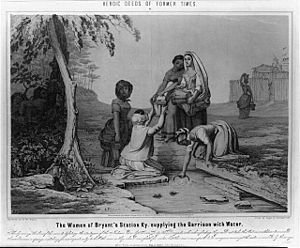Bryan Station facts for kids
Quick facts for kids Siege of Bryan Station |
|||||||
|---|---|---|---|---|---|---|---|
| Part of the American Revolutionary War | |||||||
 Illustration of the women of Bryan Station getting water while Native Americans watch, just before besieging the settlement. |
|||||||
|
|||||||
| Belligerents | |||||||
| Kentucky settlers | American Indians and allies | ||||||
| Commanders and leaders | |||||||
|
Capt. Elijah Craig or his father Capt. John Craig[1] |
William Caldwell, Alexander McKee, |
||||||
| Casualties and losses | |||||||
| 5 killed 2 wounded |
|||||||
Bryan Station was an early fortified settlement in Lexington, Kentucky. It was like a small fort made of about forty log cabins. The settlement was built around 1775 or 1776. It was founded by the Bryan brothers: Morgan, James, William, and Joseph. Their brother-in-law, William Grant, also helped. William Bryan and William Grant were related to the famous pioneer Daniel Boone.
Bryan Station was located near Elkhorn Creek. This spot was important because it was close to a natural spring. The spring provided fresh drinking water for everyone living inside the fort.
Contents
What Was the Siege of Bryan Station?
The Siege of Bryan Station was a major attack on the settlement. It happened in August 1782 during the American Revolutionary War. A large force of Native American warriors and their British allies attacked the fort. This group included Wyandots, Lake Indians, Shawnee, and Delaware Indians. They were led by Captain William Caldwell and Simon Girty.
The attackers numbered between 400 and 500 people. They secretly surrounded Bryan Station. Their goal was to capture the fort and its settlers.
The Brave Women of Bryan Station
The people inside Bryan Station knew they were surrounded. But they didn't want the attackers to know that. The fort needed water, especially in the hot summer. The spring was outside the fort walls.
The men decided to let the women go to the spring. This was a very brave plan. The attackers expected the men to go for water. If the women went, it would look like normal morning routine. This would trick the attackers into thinking they were still hidden.
The women bravely walked out of the fort. They went to the spring to collect water. The attackers watched them but did not fire. They wanted to keep their surprise attack a secret. This act of courage helped the fort survive. The water was vital for drinking and for putting out fires. The attackers were using flaming arrows to try and burn the fort.
The Attack and Its Aftermath
The attack on Bryan Station was a surprise for the settlers. The militia inside the fort did not know how many attackers there were. They also didn't know the British were helping.
The siege lasted for a few days. Eventually, the attackers gave up. Native American scouts reported that more Kentucky militia were coming. So, the attackers left Bryan Station.
The Kentucky militiamen chased after Caldwell's force. Three days later, they fought the Battle of Blue Licks. This battle happened about 60 miles northeast of Bryan Station. The militiamen were defeated in this battle.
Remembering Bryan Station Today
Today, a monument stands near the site of Bryan Station. It was put there in 1896 by the Lexington chapter of the Daughters of the American Revolution. The monument honors the brave women who fetched water from the spring. This act was very important for saving the fort.
A flaming arrow once landed near the head of an infant during the siege. This baby later grew up to be Colonel Richard Mentor Johnson. He became famous for his role in the War of 1812.
Bryan Station High School is named after this historic fort. It is located a few miles south of where the fort once stood. The school's sports teams are called the "Defenders." This name reminds everyone of the brave people who defended Bryan Station.

